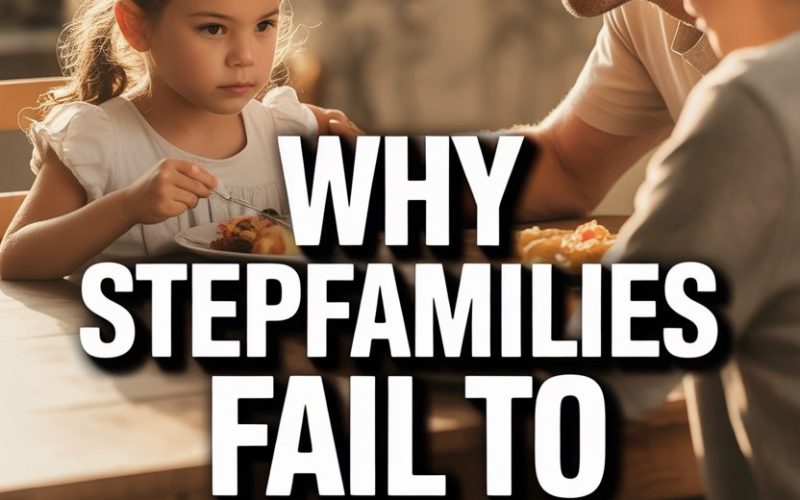Blending families is supposed to be a lovely second chance. Cue the family dinners, school pick-ups, and everyone snuggled together on the sofa, right?
But someone forgot to warn us that, quite often, it feels more like herding cats in a thunderstorm—if each cat had a different set of rules, and also, some of them hiss at each other.
Let’s get real about why stepfamilies don’t always feel like one big, happy team, and what you can (actually) do about it before you lose your marbles—or at least before bedtime.
The Myth of Instant Family
It’s tempting to believe that love conquers all. After all, Hollywood has given us enough blended family montages to last a lifetime. Everything looks peachy by the two-hour mark, with everyone hugging on the porch.
Back in reality, stepfamilies are thrown together with a mix of histories, parenting styles, and emotional baggage.
According to the American Psychological Association, it can take anywhere from two to five years for a stepfamily to start feeling cohesive. Two to five years! That’s a lot of burnt lasagnas and awkward school events.
Blending is rarely seamless. The expectation that everyone will click overnight just piles on pressure.
Instead, it’s more like building a house with mismatched Lego bricks—slow, occasionally painful, and sometimes you wish you could just step on something else.
Complicated Loyalties and Divided Hearts
Kids didn’t ask for this. Suddenly they’re expected to live with new siblings or accept a new parent figure.
It can feel like treason to their biological parent to bond with a stepparent—especially if that parent is still in the picture, and perhaps less than thrilled about their ex’s new domestic arrangement.
This is often called a loyalty bind, and it’s as tricky as it sounds. Kids may resist getting close to a stepparent simply to avoid hurting Mum or Dad.
No amount of homemade cookies can fix this overnight.
As a result, relationships stall. It’s not personal—it’s survival.
Different Rules, Different Worlds
Some kids are expected to take their shoes off at the door. Others wander around with muddy rugby boots and no one bats an eyelid.
When two households merge, so do their rulebooks.
These differences spark confusion and resentment, especially when parents try to enforce “their” way. According to Family Lives, consistency is essential, but finding common ground takes time.
Kids are experts at sniffing out inconsistencies—watch them exploit it for all it’s worth.
And when rules don’t line up, power struggles aren’t far behind. Suddenly, a forgotten towel on the floor becomes a metaphor for the collapse of Western civilisation.
Discipline Dilemmas
This is where things get spiky. Stepparents often walk a tightrope: discipline too much, and you’re the evil stepmother; discipline too little, and you’re a pushover.
A study found that kids are more likely to rebel when discipline comes from someone they don’t see as an authority figure—especially if their biological parent lets things slide. Cue resentment on all sides.
Until stepparents and biological parents unite on discipline (and present a halfway-friendly front), kids will continue to play them off each other.
It’s almost impressive. If only they applied this cunning to algebra.
Ghosts of Relationships Past
Every family member drags their own history behind them like a suitcase on dodgy wheels. Divorce, bereavement, or just the memory of “how it used to be” can haunt even the happiest new start.
This is particularly true for kids, who might secretly hope their parents will get back together (no pressure). They may keep everyone at arm’s length or act out, trying to test the stability of this new arrangement.
Adults aren’t immune either.
Stepparents can feel insecure, especially if the ex is still on the scene—or on WhatsApp, or turning up every Saturday with new trainers. And biological parents might struggle with guilt or the sense they’re asking their kids to “move on” too soon.
The Invisible Workload and Resentment
Blending families isn’t just emotional heavy-lifting—it’s actual, physical work. Suddenly, there are more uniforms to wash, more food to cook, and new schedules to sync.
Often, one adult (usually Mum, let’s be honest) picks up the slack. If nobody acknowledges this invisible effort, resentment builds like unwashed dishes in the sink.
Even the best intentions can crumble when exhaustion takes over. A study in Utah State University points out, stepfamilies need more communication, not less.
Unfortunately, “more talking” doesn’t always sound appealing after cleaning up a spaghetti explosion.
Carrying Old Baggage into New Rooms
Stepfamilies are a whirlwind of change. But if members are still clinging to old hurts, or clutching the “way things used to be,” building new bonds becomes all but impossible.
Kids might idealize their previous family setup. Parents might carry guilt or feel defensive about bringing new people into the fold.
Stepparents often worry they’re overstepping, or not doing enough.
Until everyone acknowledges that this is a new family, with its own potential for mess and magic, those old stories will keep tripping everyone up.
The Pressure Cooker of Expectations
Self-help books, social media, and well-meaning relatives love to chime in with how things “should” be. Ever been told, “You’ll feel like a real family in no time!”? No pressure.
This expectation is a recipe for disappointment. The more you chase a picture-perfect family, the worse it feels when you fall short.
Instead, experts at Child Mind Institute recommend focusing on tiny connections: a shared joke, a pizza night, or a brief chat in the car.
Real family feeling is built from small, unremarkable moments—often when nobody’s looking.
The Ex Factor
Some exes stick to their lane. Others are more like the guest who refuses to leave your barbecue, offering constant commentary on your grilling.
Frequent contact, bitterness, or outright sabotage can make the new household feel like a never-ending episode of “EastEnders”.
Kids can also become unwitting messengers, carrying complaints and comparisons between homes.
This only deepens the sense that nobody is truly “together”—everyone’s still living in separate worlds, even if they share a roof for half the week.
Boundary-setting is key, though it may involve more awkward conversations and WhatsApp blocks than anyone bargained for.
Money, Space, and the Dreaded “Fairness”
It’s the classic stepparent nightmare: one child gets a new phone, the other is still playing Snake on a cracked Nokia. Or perhaps a new stepchild nabs “their” bedroom, and World War III breaks out.
Fairness is a loaded word in stepfamilies. Finances rarely blend as easily as hopes do. Kids notice every penny, every treat, every missed opportunity.
If anything feels even slightly off, it’s “You love them more!” before you’ve finished your cuppa.
Experts at Relate stress the importance of agreeing rules on spending, sharing, and personal space. Even the dog might need a new rota.
Jealousy, Grief, and Guilt: The Step Monster Trifecta
These emotions aren’t fun to talk about, but they’re as much a part of family life as lost socks. Kids can feel jealous of their parent’s attention, grieve the family they lost, or feel guilty for liking their new stepparent.
Stepparents themselves may secretly battle jealousy if their partner’s kids come first (spoiler: they almost always do). Guilt over resenting a child, or even wishing for a less complicated life, is common too.
Pretending these emotions don’t exist only gives them more power. A bit of honesty, and perhaps a family group chat where you can all laugh about your collective awkwardness, works wonders.
Building Something Real
It’s not all doom and gloom. Families—step or otherwise—aren’t defined by labels or photo albums.
They’re forged in the everyday: burnt toast, mismatched socks, a joke that only makes sense to your lot.
No two stepfamilies look the same, and there’s no magic formula. The trick is to lower the bar, ditch the Hollywood scripts, and celebrate tiny steps.
Maybe nobody’s hugging on the porch yet, but you’ve survived another dinner with only minor arguments. That counts.
If you’re feeling stuck, consider outside help. A few sessions with a family therapist can help everyone feel heard—and maybe stop the “who left the milk out?” fights spiraling into the next ice age.
When the Teacups Settle
Stepfamilies don’t fail because anyone is lazy or unloving. The challenge is bigger: It’s learning to love in a way that feels foreign, in a house filled with history.
The best advice? Give it time. Let people have their feelings. Keep the kettle on, the lines of communication open, and your sense of humor handy.
That new family feeling sneaks up, not in grand gestures, but in the ordinary: someone sharing their chips, a quick smile in the car, a new in-joke that belongs only to you lot.
You’re not failing. You’re building.
And one day, you’ll look up and realize—despite the chaos—you’ve made something brilliantly your own.





